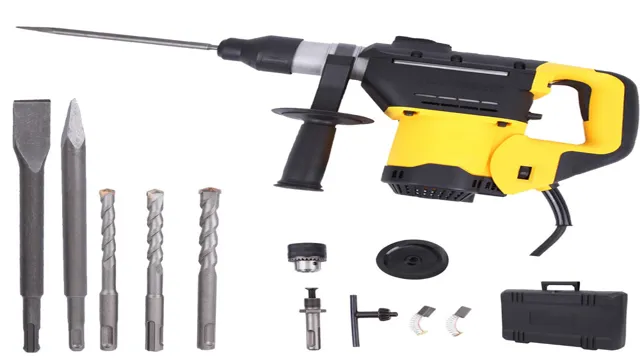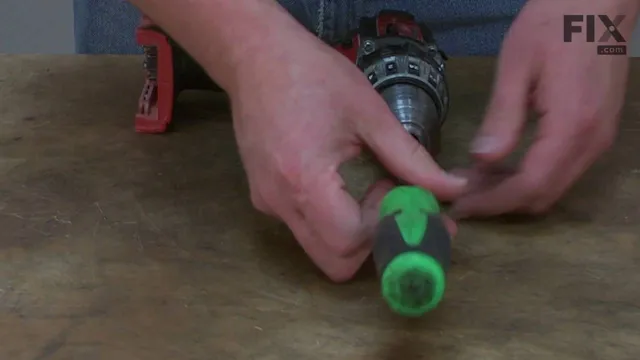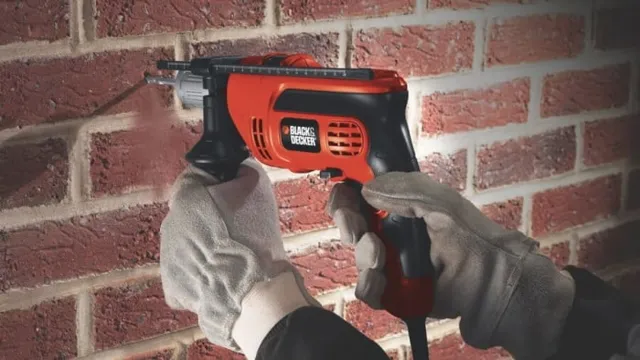Can You Use a Hammer Drill on Porcelain Tile? Tips and Techniques.
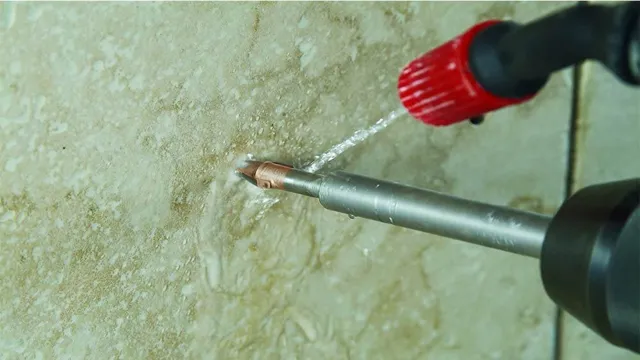
Introducing a new porcelain tile to any space is an excellent way to elevate its aesthetic appeal. However, brute strength cannot be used to handle the delicate surface of porcelain tiles. Porcelain tile is made of highly dense and brittle material, which requires specialized tools to drill effectively.
A hammer drill is a power tool that can make the job a lot easier. In this blog, we are going to introduce you to the necessary things you need to know when utilizing a hammer drill on porcelain tile. From the right drill bit to the appropriate techniques, we’ve got you covered.
So, if you’re looking to add a touch of elegance to your home, grab a cup of coffee, and allow us to guide you through this informative piece.
Understanding Porcelain Tile
If you’re wondering whether you can use a hammer drill on porcelain tile, the answer is yes, but with some precautions. Porcelain tile is a hard and durable material, but it’s also brittle and prone to cracking or chipping if you apply too much force or pressure. Therefore, it’s essential to use the right drill bit and drilling technique to avoid damaging the tile.
You should choose a diamond-tipped drill bit that is designed specifically for drilling through porcelain tile. Also, you should use a slow rotational speed and apply gentle pressure to prevent the bit from overheating or causing the tile to crack. With the proper tools and technique, drilling through porcelain tile can be a straightforward task that will allow you to install fixtures or hang decorations on your walls and floors.
Porcelain Tile Composition
Porcelain Tile Composition If you’re in the market for new flooring or tile, you may have heard the term porcelain tile thrown around. But what is porcelain tile, exactly? Porcelain tile is made from a mix of fine-grain clays and minerals that are baked at extremely high temperatures, which creates a dense and hard material. This makes porcelain tile more durable than other types of tile and resistant to stains, scratches, and moisture.
The composition of porcelain tile makes it a great option for high-traffic areas, such as kitchens and bathrooms, as well as outdoor spaces. Plus, because of the way it’s made, porcelain tile comes in a wide variety of colors, patterns, and styles, making it a versatile option for any design aesthetic.
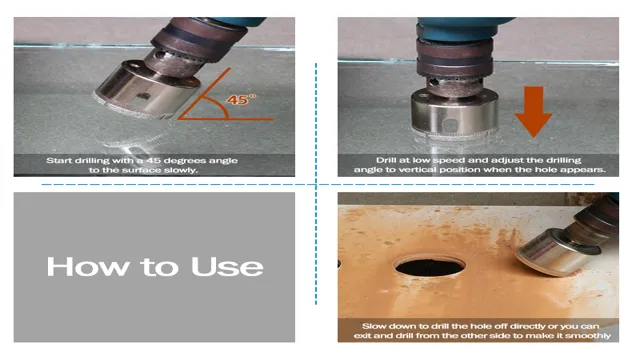
Porcelain Tile Properties
Porcelain tile is a popular choice for flooring due to its durability and versatility. It is made from a fine mixture of clay and other natural materials, which are then fired at high temperatures to create a hard and dense material. The resulting porcelain tile is impermeable to water, making it ideal for use in areas with high moisture levels.
Its strength also makes it an excellent choice for high traffic areas such as commercial spaces and homes with pets or young children. Additionally, porcelain tile designs can mimic the look of natural stone, wood, and other materials, providing homeowners with a variety of options to match their personal style. Overall, understanding the properties of porcelain tile can help you make informed decisions when selecting flooring options for your home or business.
Porcelain Tile Strength and Durability
Porcelain tile has become increasingly popular due to its strength and durability, making it an ideal choice for both residential and commercial settings. Unlike ceramic tile, porcelain tile is made from more refined clay and fired at a higher temperature, resulting in a denser and harder product. This makes it highly resistant to heavy foot traffic, scratches, and stains, making it a great choice for areas with high wear and tear.
Additionally, porcelain tile is non-porous, meaning it won’t absorb water, making it perfect for use in bathrooms, kitchens, and other areas where moisture may be an issue. Overall, porcelain tile is a smart investment for those seeking a long-lasting, beautiful, and durable flooring option.
Introduction to Hammer Drills
When it comes to drilling into porcelain tile, using a hammer drill can be a smart choice. But not all hammer drills are created equal. It’s important to choose one with the right features for the job.
Look for a hammer drill with a variable speed control, as this will allow you to adjust the speed based on the hardness of the tile. Additionally, make sure the drill has a depth stop, which will make it possible to drill holes to a consistent depth. Finally, be sure to use the right bit for the job.
A carbide-tipped masonry bit will work well for drilling into tiles. With the right tools and proper technique, you can absolutely use a hammer drill on porcelain tile to create precise and clean holes.
Hammer Drill Functionality
Hammer drill Hammer drills are power tools that combine the functionality of a rotary drill and a hammer. The hammer drill’s primary purpose is to drill holes in tough materials like concrete and masonry. The hammer function delivers thousands of small impacts per minute, allowing for greater drilling force without placing too much stress on the motor.
The high level of force generated by the hammer action improves the drill’s efficiency, enabling it to penetrate even the toughest surfaces that a regular drill could not manage. Hammer drills come with different modes, including drill mode, hammer mode, and chisel mode, giving users more options to handle different tasks. With its versatility and efficiency, the hammer drill is an essential tool for those working in construction, renovation, and DIY projects.
Types of Hammer Drills
Hammer drills are versatile power tools that can help make any DIY project simpler and more efficient. They can drill into various materials like concrete, brick, and stone, making them an essential tool for construction and home improvement projects. Hammer drills work by using a combination of impact and rotation to make holes quickly and easily.
There are different types of hammer drills that are available in the market today. The most common ones are corded, cordless, and rotary hammer drills. Corded hammer drills are powered by electricity, while cordless hammer drills are powered by rechargeable batteries, and rotary hammer drills are used for larger drilling projects.
Each of these types has its own unique set of features that make them ideal for different projects. If you’re looking for a hammer drill, be sure to choose the one that best suits your specific needs.
Hammer Drill Features to Consider
Hammer drills are versatile power tools that can drill through various materials such as concrete, brick, and stone. They serve a wide range of purposes and are commonly used in construction and DIY projects. Hammer drills are equipped with a special mechanism that makes them suitable for drilling through hard surfaces.
As the drill rotates, a hammer mechanism delivers quick bursts of pressure that pulverize the drilling surface, making it easier for the drill bit to create a hole. When choosing a hammer drill, it’s essential to consider the features that suit your needs. Some of the essential factors include the drill’s motor power, speed, chuck size, and clutch settings.
A powerful motor, for instance, can help you effortlessly bore holes in concrete or masonry surfaces. Additionally, a variable speed control feature can allow you to adjust the drilling speed to your liking. Lastly, you should choose a hammer drill with a high clutch setting because it can help you avoid damage to the drill when it encounters a tough blockage.
Overall, hammer drills are an excellent investment for anyone looking to tackle heavy-duty drilling projects.
Using a Hammer Drill on Porcelain Tile: Possible Risks and Precautions
If you’re wondering whether you can use a hammer drill on porcelain tile, the answer is yes! However, it’s important to take necessary precautions to avoid damaging your tile. Porcelain tile is durable and tough but also very brittle. That means you need to use a hammer drill with a diamond-tipped bit that’s designed for use on hard surfaces.
Additionally, you need to apply steady pressure and use a slow, controlled drilling motion to prevent cracks or chips from forming on the tile surface. One tactic to reduce the chances of damaging your tile is to apply masking tape or a piece of duct tape on the surface before drilling. This can help to keep the surface intact and prevent any slippage while drilling.
When drilling, start at a low speed and gradually increase to a higher speed, keeping the drill level at all times. By taking the necessary precautions, you can use a hammer drill on porcelain tile without risking damage to the material.
Potential Damage to Porcelain Tile
When it comes to drilling into porcelain tile, it is important to be aware of the potential risks and take necessary precautions. While a hammer drill can be an efficient way to make holes, it can also cause damage to the tile if not used correctly. One risk is that the drill bit can crack or chip the tile, resulting in unsightly and potentially costly damage.
To avoid this, it is important to use a drill bit specifically designed for drilling into porcelain tile and to apply steady, even pressure throughout the drilling process. It is also recommended to use a cooling agent to prevent overheating and to drill at a slow speed to reduce the risk of bursts. Taking these precautions can help ensure a successful and damage-free drilling experience on porcelain tile.
Safety Measures to Take
If you are planning to use a hammer drill on porcelain tile, it is crucial to take precautions to ensure your safety. Hammer drills can be powerful machines and can cause serious accidents if not handled correctly. One of the first things to do is to wear eye protection to prevent flying debris from hurting your eyes.
It is also essential to wear a pair of earplugs or earmuffs to protect your ears from the loud noise. Before starting, ensure that the porcelain tile is secure and not at risk of slipping or falling. Use a level to check if the surface is even.
If not, consider using a different tool or method. It is also beneficial to mark the area you plan to drill with some masking tape to prevent the drill bit from slipping and causing scratches. Always use a sharp drill bit and start drilling at a low speed to avoid cracking the porcelain tile.
As you progress, increase the speed gradually and pull the drill back slightly to remove any dust buildup. Remember to take breaks and rest your arms as using a hammer drill for a prolonged period can cause fatigue and strain. By following these precautions, you can safely use a hammer drill on porcelain tile without any mishaps.
Tips for Successful Use of a Hammer Drill on Porcelain Tile
Yes, you definitely can use a hammer drill on porcelain tile. However, the process requires a bit of finesse, and there are a few tips to keep in mind to prevent any damage or breakage. First off, you’ll need to choose the correct drill bit.
Ideally, you’ll want to opt for a diamond-tipped drill bit, as it is specifically designed to handle hard materials like porcelain. It’s also crucial to go slow and steady with your drilling, using a low speed and gentle pressure to avoid cracking or chipping the tile. Furthermore, it’s a good idea to use a hammer drill with a depth stopper to help prevent over-penetration.
And last but not least, take the necessary safety precautions – wear eye protection, work gloves, and work slowly and carefully to avoid any accidents or mishaps. By following these tips, you can successfully use a hammer drill on porcelain tile without any damage or complications.
Selecting the Right Drill Bit
When it comes to drilling through porcelain tile, selecting the right drill bit is essential for a successful outcome. The most commonly used drill bit for this purpose is a carbide-tipped masonry bit. This type of bit is designed to handle hard, dense materials like ceramic and porcelain by using a sharp, pointed tip to create a pilot hole and wider flutes to remove debris.
However, even with the right bit, drilling through porcelain tile can be challenging. That’s where a hammer drill comes in handy. Its hammering feature can help break through the tile’s hard surface and prevent cracking.
To use a hammer drill on porcelain tile, it’s essential to keep the drill bit perpendicular to the surface and avoid applying too much pressure. A light touch and patience are key. By following these tips and using the proper equipment, you can successfully drill through porcelain tile without damaging your surface.
Prepping Porcelain Tile Surface
If you’re planning on prepping a porcelain tile surface for a project, you might need a hammer drill. However, drilling through porcelain tile can be tricky and even dangerous if you don’t know what you’re doing. Here are a few tips to ensure a successful use of a hammer drill on porcelain tile.
First, make sure to use a diamond drill bit designed specifically for porcelain tiles. This will ensure a cleaner and safer cut. Second, use a low speed setting when drilling and apply gentle pressure.
The last thing you want is to crack the tile. Third, make sure to wear protective gear such as goggles and gloves. Finally, if you’re not confident in your ability to drill through porcelain tile, it may be best to hire a professional instead.
With these tips in mind, you should be able to prep your porcelain tile surface without any major issues.
Drilling Techniques and Speeds
If you’re planning to install porcelain tile, you’ll need to make holes in it to fix it to walls, floors, or ceilings. A hammer drill is a powerful tool that can help you get the job done quickly, but using it on porcelain tile can be tricky. To achieve success, there are a few things you should keep in mind.
First, use a carbide-tipped masonry bit that’s designed to drill through tile. Second, start drilling at a slow speed and gradually increase the speed as you go. This will prevent the bit from overheating and cracking the tile.
Third, apply only light pressure to avoid cracking the tile too. Finally, always use water to keep the bit cool and prevent dust from building up. With these tips, you’ll be able to drill through porcelain tile with ease and get your installation done in no time.
Conclusion
In conclusion, using a hammer drill on porcelain tile is like wearing high heels to a hike in the mountains – technically possible, but not a very smart idea. While porcelain tile is known for its durability, it is also notoriously difficult to drill through without causing damage. A hammer drill, with its intense power and speed, could easily crack or chip the tile.
So, unless you want your bathroom renovation to turn into a DIY disaster, it’s best to invest in a specialized tile drill bit and take things slow and steady. Happy drilling!”
FAQs
What is a hammer drill and how does it work?
A hammer drill is a power tool that combines rotary drilling with a hammering action to work through tough materials like concrete and masonry. With special masonry drill bits, a hammer drill can also be used on porcelain tile.
Can a regular drill be used on porcelain tile?
It is not recommended to use a regular drill on porcelain tile as it may crack or damage the tile.
What type of drill bit should be used for porcelain tile?
A diamond-tipped drill bit is the best option for drilling porcelain tile as it is strong enough to cut through the hard material without causing damage.
Can a hammer drill be used for both drilling and chiseling porcelain tile?
Yes, a hammer drill can be used for both drilling and chiseling porcelain tile with the appropriate attachment.
What safety precautions should be taken when using a hammer drill on porcelain tile?
Always wear eye protection and dust masks to avoid inhaling dust particles. Start with a lower speed to avoid cracking the tile and apply steady pressure while drilling to prevent slipping.
How do I clean the dust created from drilling porcelain tile?
Use a wet sponge or cloth to wipe away the dust regularly to prevent it from accumulating and affecting the drilling performance.
Can I use a cordless drill on porcelain tile?
Yes, a cordless hammer drill with a diamond-tipped drill bit can be used on porcelain tile, but the battery life may be shorter compared to using a corded drill.

